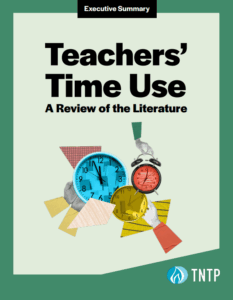Are we facing a teacher shortage crisis? It’s a question that’s dominated education news this back-to-school season. There doesn’t seem to be an easy answer: some districts are clearly struggling to fill open teaching positions, while the hiring process has never been more competitive in others.
Either way, what’s missing from the conversation is a serious attempt to get to the root of the problem. Teacher shortages are usually framed like droughts—forces of nature that school systems can neither predict nor control. But as we’ve learned in almost two decades of hiring teachers across the country—and, more recently, in a study of teacher pipelines in five school districts—there’s a lot that school systems can do to affect the quality of teacher pipelines year in and year out. Here are three big ones:
Forecasting hiring needs, especially for the long run: Many districts struggle to forecast their teaching vacancies year-to-year, but even those that have a handle on their short-term staffing needs often don’t have the bandwidth to think about how those needs might change several years from now.
A case in point: Rising enrollment in a universal pre-kindergarten program in one district we studied will likely require more than 100 new pre-K teachers within the next few years. At the same time, the number of English language learners in the district is expected to grow steadily for at least the next decade. These trends will likely require major adjustments to the district’s recruitment strategy—changes that could and probably should start immediately. The lesson: Building the capacity to forecast and address hiring needs for the short term and the long term is critical.
Matching supply with demand: Focusing on the total enrollment in preparation programs masks the more complicated reality districts face in their hiring. They don’t just need a particular number of teachers; they need specific numbers of teachers trained in specific subject areas and specialties. (They also need good teachers, not just any teachers—another dimension enrollment numbers don’t capture—but that’s a whole other issue.)
In another district we studied, for example, the overall number of teachers the district will need to hire will not change dramatically in the foreseeable future, but changes in demographics will require many more bilingual teachers than ever before. Unfortunately, the supply in this district is not set up to meet the demand: enrollment in local teacher preparation programs dropped by 45 percent in this subject area over the last four years.
The solution here is for districts to partner more closely with local preparation providers to calibrate on supply and demand. For example, Shelby County Schools in Tennessee meets regularly with six local universities to compare notes on the district’s hiring needs and how the universities can help meet them.
Districts may also want to explore ways to make it easier for their best teachers to build skills and gain certification in hard-to-staff areas—for example, by providing add-on certifications in areas like special education at little or no cost—or to create lower-cost entry points into the profession for talented substitutes, paraprofessionals, and others who are already in school-based roles.
Keeping top teachers in the classroom: Amid all the focus on hiring challenges, it’s easy to forget about the other end of the teacher pipeline: retention. Providing students with great teachers—especially in hard-to-staff subjects—starts with going all-out to keep great teachers who already work in a district in their classrooms for as long as possible. This isn’t rocket science; sometimes it’s as easy as simply telling great teachers they’re important and asking them to come back. But districts often fail to focus closely enough on retaining top teachers, and lose too many as a result.
In addition to being more intentional about asking great teachers to stay, districts should explore developing teacher leadership roles that allow teachers to take on more responsibility while staying in the classroom, or rethinking compensation to offer more incentives for top teachers to stay, especially in critical shortage areas. (Compensation can also help with the recruitment end of the pipeline, too: for example, Cleveland Metropolitan School District recently started offering novice teachers higher salaries than surrounding districts. Coupled with a strong recruitment campaign, this has triggered a 55 percent increase in applications this year.)
The news stories about the teacher drought are shedding light on real issues in many school systems, but there’s no reason to panic. Instead, it’s time for school districts to refocus their staffing efforts on strategies that will help shore up their teacher pipelines—so that more students get to learn from the teachers they deserve, next year and in the years to come.








